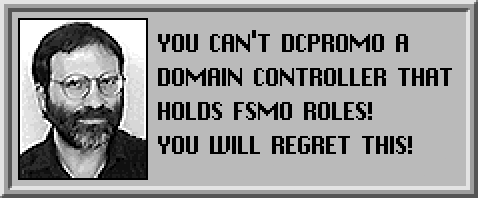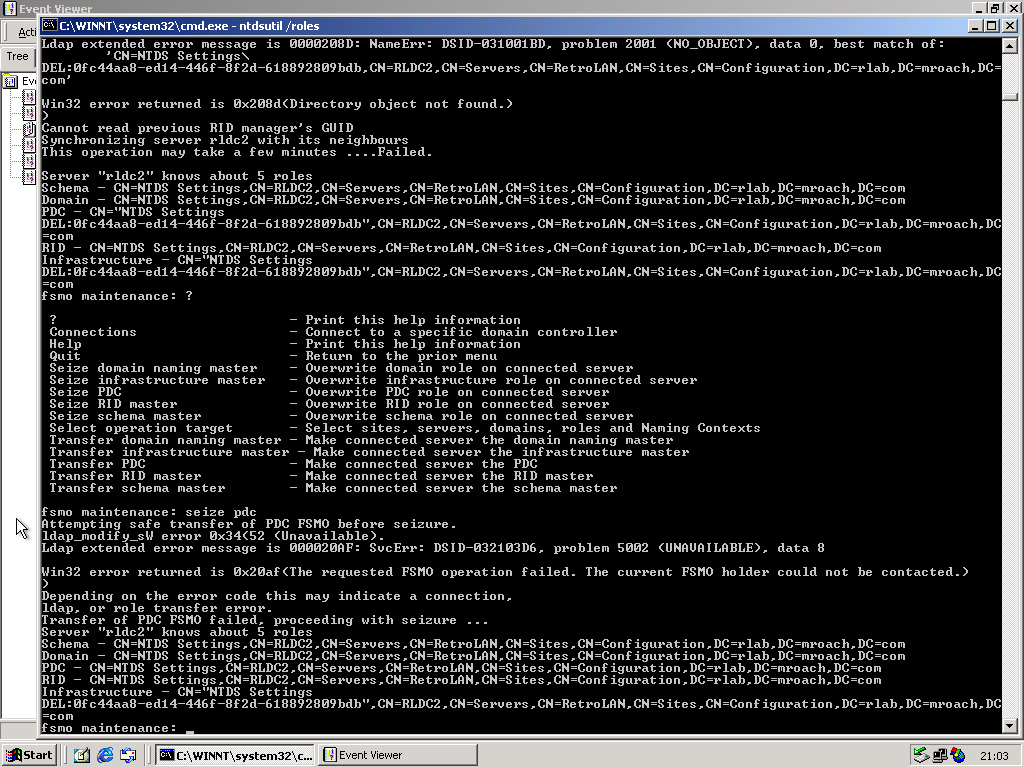Windows 2000 Domain Recovery
I have a Windows 2000 Active Directory domain that had one domain controller. I added a second domain controller and performed what I thought were all necessary steps to prepare the new domain controller to be the only one in the domain. Turns out I missed a few key steps and broke my domain.
In hindsight I think Windows warned me, but I was so sure I did it all right. If only they had warned me properly in a way that would truly alarm me:

How I partially decommissioned the server
- In Active Directory Sites and Services, I enabled Global Catalog by right-clicking on NTDS Settings for the new controller.
- In Active Directory Users and Computers, I right-clicked on the domain, clicked Operations Masters… and set my new controller to the RID, PDC, and Infrastructure master.
As far as I understood at the time, this should have done the trick. After running dcpromo
on the old controller to demote it, things started going wrong. I could no longer
join the domain on new computers. I would get errors about not being able
to allocate a resource identifier. Uh oh. Clearly I missed something.
Debugging
You’ll want to have the Windows 2000 Support Tools installed.
The installer is on the Windows 2000 CD in Support\Tools\setup.exe.
I ran dcdiag to see what was going on.
Things went wrong with the KnowsOfRoleHolders tests. I would get:
Warning: CN="NTDS Settings DEL:... is the PDC Owner, but is deleted.
Warning: CN="NTDS Settings DEL:... is the Rid Owner, but is deleted.
Warning: CN="NTDS Settings DEL:... is the Infrastructure Update Owner, but is deleted.
Then, the RidManager test would fail too:
Warning: FSMO Role Owner is deleted.
Warning: rid set reference is deleted.
ldap_search_sW of CN=RID Set DEL:... for rid info failed with 2: Win32 Error 2
Things were looking grim and a lot of the search results I found didn’t really help.
One of them spoke of using ntdsutil to do metadata cleanup, but this didn’t work for me.
The Fix
I finally found that ntdsutil was the tool for the job, but nobody had documented
how to fix my specific problem. So, here’s how I fixed it.
ntdsutil has an interface where you enter menus and sub menus. Some menus have
you set state and then go back and use those settings.
You can type ? and hit Enter to get help and lists of commands.
In my case the domain controller is RLDC2.
- Open
cmd.exeand runntdsutil - Type
roles, hit Enter. - Type
connections, hit Enter. - Type
connect to server RLDC2, hit Enter.
Now you’re connected to the domain controller that you want to seize the missing operations master roles.
You should be at a prompt that says fsmo maintenance:.
Now we’ll seize roles one by one, answering Yes to all prompts.
- Type
seize infrastructure master, hit Enter. - Type
seize pdc, hit Enter. - Type
seize rid master, hit Enter.
Now if you run dcdiag you should get a passing result! At least I did.
The session should look something like:
C:\> ntdsutil
ntdsutil: roles
fsmo maintenance: connections
server connections: connect to server rldc2
server connections: quit
fsmo maintenance: seize infrastructure master
fsmo maintenance: seize rid master
fsmo maintenance: seize pdc
fsmo maintenance: quit
ntdsutil: quit

What I missed
The first time around I missed transferring two key roles: Schema Master and Domain Naming Master.
Microsoft has this well-documented and I still missed it.
Since this mess I decommissioned this server and this time I did it properly. This was all still a valuable learning experience and I’m glad for it ultimately.
